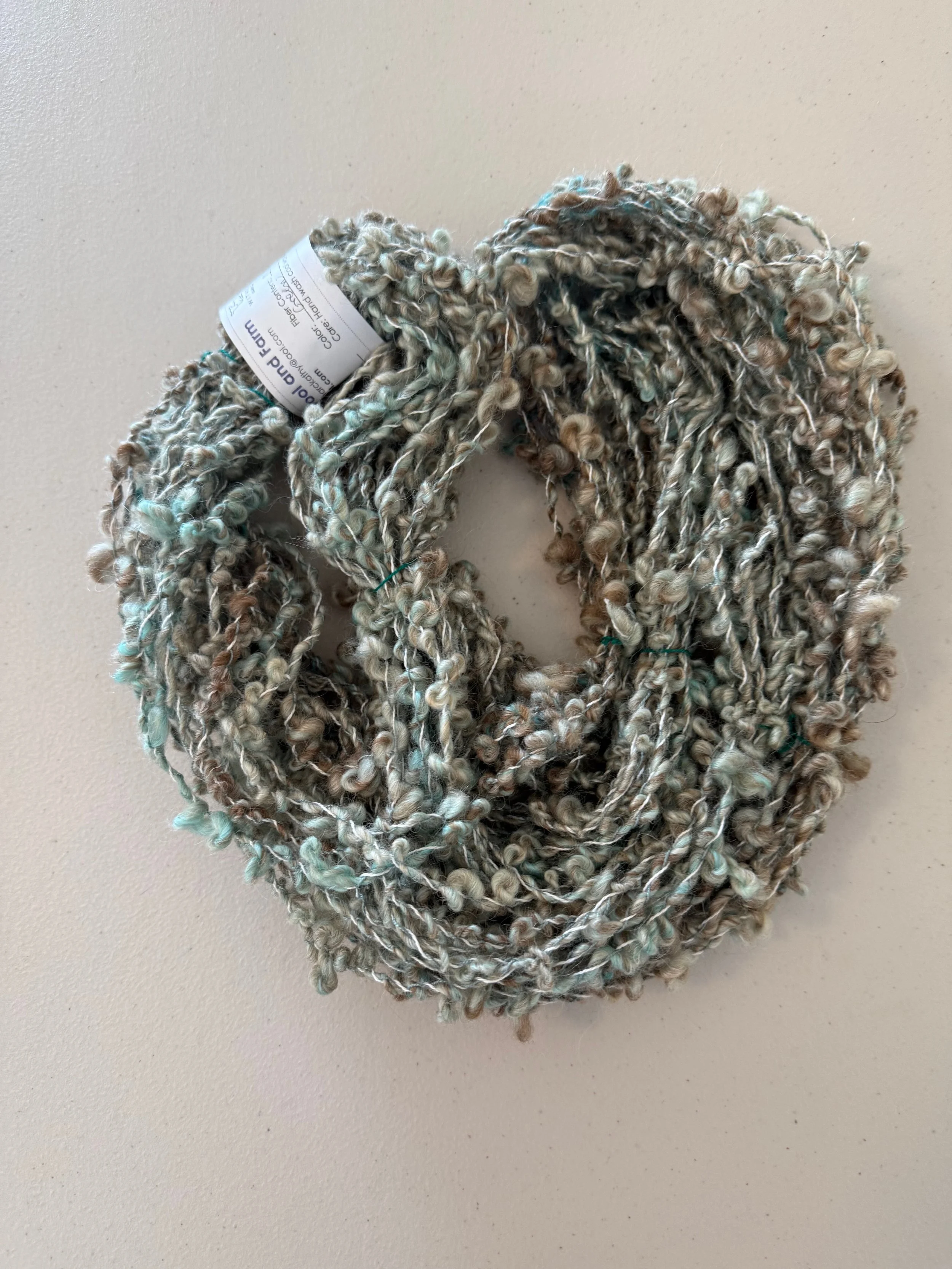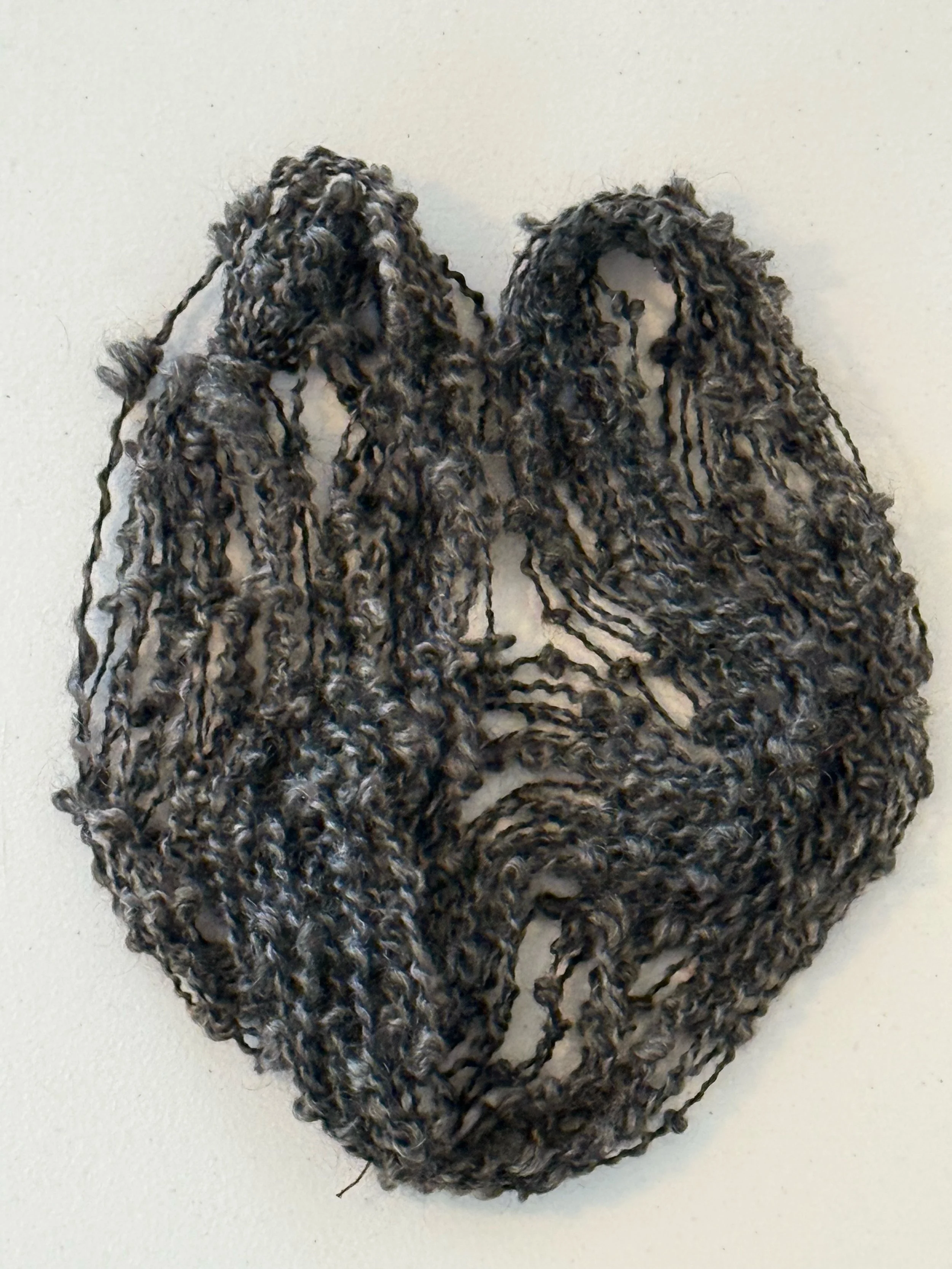Boucle Yarns
I recently have been spinning boucle yarns and am going to discuss them in more detail. Boucle yarn is a type of art yarn that features loops or curls along its strand. Bouclé" is a French word meaning "to buckle" and this yarn is often used to add visual interest to projects and the series of loops on the yarn creates a soft, bouncy texture.
Because of its unique texture, boucle yarn can be more difficult to work with compared to traditional yarns. The loops can sometimes get caught on your crochet hook or knitting needle, making it more challenging to create even stitches. Additionally, it can be hard to see your stitches due to the yarn’s texture. However, with a bit of practice and patience this yarn doesn’t have to be exclusively for an experienced knitter or crocheter.
When it comes to choosing the right projects for boucle yarn, it’s important to keep in mind the nature of this yarn. Boucle yarn is best suited for projects that showcase its texture - such as scarves or shawls. These projects allow the yarn to be the star of the show, while also providing warmth and coziness. Another great option for boucle yarn is hats and headbands; the boucle yarn can add a fun and playful look. Additionally, boucle yarn is great for adding accents to larger projects, such as using it for a border on a blanket.
Using a boucle yarn requires some special attention and care. While it can be a bit tricky to work with at first, with practice, it can become an enjoyable experience. If you’re new to using boucle yarn, here are some points to keep in mind:
1. Consider using a larger hook or needle size than you would normally use for the same yarn weight. This will help you avoid snagging the circles and make it easier to see your stitches as you work.
2. Be patient and work slowly. Boucle yarn has a tendency to tangle and catch on itself, so take your time and be careful with each stitch.
3. Pay attention to your tension. Boucle yarn can be more difficult to keep even than other types of yarn, so make sure you’re not pulling too tightly or working too loosely.
4. Consider using simple stitches. More intricate stitches can be lost in the texture of boucle yarn, so stick to simpler stitches or patterns that showcase the yarn’s unique texture.
To spin a traditional boucle yarn you need a yarn to serve as the core, one to loop and buckle around the core and finally one to lock the loops in place. Mohair is the perfect fiber to use to make the yarn you will use to create the loops; mohair has a bend-resistant nature and more easily (versus wool) forms the loops you want for a boucle yarn. Note, for your core yarn and your final ply yarn, you can use commercial thread/yarn.
Many books and videos show the specific mechanics in making a boucle yarn. Essentially you first take your core yarn straight out from the orifice and hold the yarn you will be making the loops with 45 to 90 degrees out from the core (with less tension than the core). You slide your fiber supply hand back an inch or so and them move that small section of your yarn towards the core; then, with the same hand, when it reaches the core, push the wrapped yarn towards the orifice so that it creates a loop. (I find it easier sometimes to pull the yarn up towards the orifice – rather than pushing it.) Then repeat this process until you are done. (This plying to make the loops can take practice.) Now to balance your yarn, and keep your loops from sliding around, you will need to ply in the opposite direction. (The yarn/thread used in this last step is called the locking yarn/thread.) Hold the locking thread straight out from the orifice and the buckled yarn (with the loops) at a slight angle and let the buckled yarn wrap around the locking thread. And then you are done! (See picture below.)
Classic boucle yarn
Jacey Boggs Faulkner (great fiber artist) has a technique called “fauxcle” – which makes a boucle-like yarn with a slightly different method. This technique requires a yarn you have spun which will be the wrapping ply (to make the loops) and another single or commercially spun yarn that will act as the core. If you use a commercial yarn for the core, you will need to introduce twist in it opposite of the direction of your ply. (i.e. if you will ply in the S counterclockwise direction, you will want your core and wrapping yarn both to have Z, clockwise, twist.) You form your loops in the same way as described above. What you also do to help the loops from sliding around too much is to form an anchor every few inches. To form your anchors pull the wrapping ply straight from the orifice and the core ply out to the side at a 90 degree angle. Let the core ply wrap a few times in the same spot to form your anchor. If your wrapping yarn (used to form the loops), is mohair and your core thread/yarn is not too slick, you may be able to get by without making the anchors. (Picture of a yarn made with the fauxcle technique below.)
Fauxcle yarn
One more alternate technique. Spin yourself a nice single. Then ply it with a commercial yarn that has a boucle look. For this, I would suggest your hand spun yarn be bigger (in diameter) than the commercial yarn and I think it also helps if it does not have too much twist. (And you would want to add some twist to the commercial yarn before you ply with it.) This is a relatively fast way to get a boucle-like look. (And no, it isn’t “cheating” - it’s your yarn and there is nothing wrong with combining hand spun and commercial thread/yarn for a unique look.)


